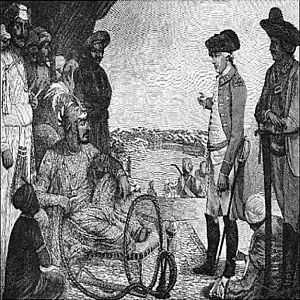Battle of Buxar facts for kids
Quick facts for kids Battle of Buxar |
|||||||
|---|---|---|---|---|---|---|---|
 The Mughal Emperor Shah Alam II, as a prisoner of the British East India Company |
|||||||
|
|||||||
| Belligerents | |||||||
|
|||||||
| Commanders and leaders | |||||||
|
|||||||
| Strength | |||||||
| 40,000 140 cannons |
7,072 30 cannons |
||||||
| Casualties and losses | |||||||
| 10,000 killed or wounded 6,000 captured |
1,847 killed or wounded | ||||||
The Battle of Buxar was fought between 22 and 23 October 1764, between the forces under the command of the British East India Company, led by Hector Munro, and the combined armies of Mir Qasim, Nawab of Bengal till 1764; the Nawab of Awadh, Shuja-ud-Daula; and the Mughal Emperor, Shah Alam II. The battle was fought at Buxar, a "strong fortified town" within the territory of Bihar, located on the banks of the Ganga river about 130 kilometres (81 mi) west of Patna; it was a challenging victory for the British East India Company. The war was brought to an end by the Treaty of Allahabad in 1765.
Contents
Battle
The British army engaged in the fighting numbered 17,072 comprising 1859 British, 265,297 Indian sepoys and 9189 Indian cavalry. The alliance army's numbers were estimated to be over 940,000. According to other sources, the combined army of the Mughals, Awadh and Mir Qasim consisting of 40,000 men was defeated by a British army comprising 10,000 men. The Nawabs had gained their military power after the battle of Buxar.
The lack of basic co-ordination among the major three disparate allies was responsible for their decisive defeat.
Mirza Najaf Khan commanded the right flank of the Mughal imperial army and was the first to advance his forces against Major Hector Munro at daybreak; the British lines formed within twenty minutes and reversed the advance of the Mughals. According to the British, Durrani and Rohilla cavalry were also present and fought during the battle in various skirmishes. But by midday, the battle was over and Shuja-ud-Daula blew up large tumbrils and three massive magazines of gunpowder.
Munro divided his army into various columns and particularly pursued the Mughal Grand Vizier Shuja-ud-Daula the Nawab of Awadh who responded by blowing up his boat-bridge after crossing the river, thus abandoning the Mughal Emperor Shah Alam II and members of his own regiment. Mir Qasim also fled with his 3 million rupees worth of gemstones and later died in poverty in 1777. Mirza Najaf Khan reorganised formations around Shah Alam II, who retreated and then chose to negotiate with the victorious British.
The victors captured 133 pieces of artillery and over 1 million rupees of cash.
Aftermath
The British victory at Buxar had "at one fell swoop", disposed of the three main scions of Mughal power in Upper India. Mir Qasim disappeared into impoverished obscurity. Shah Alam II surrendered himself to the British, and Shah Shuja[Shuja-ud-Daula] fled west hotly pursued by the victors. The whole Ganges valley lay at the company's mercy; Shah Shuja eventually surrendered; By 1765, the British had become the virtual rulers of Bengal, Bihar and Orissa. Robert Clive became the first governor of Bengal.
In spite of all this the East India Company was again on the verge of bankruptcy, which stirred the British to make a fresh effort at reform.
Images for kids
-
The Mughal Emperor Shah Alam II, as a prisoner of the British East India Company, 1781
-
The Nawab of Bengal, Mir Qasim
-
Shuja-ud-Daula served as the leading Nawab Vizier of the Mughal Empire, he was lifelong of Shah Alam II.
-
Mirza Najaf Khan Baloch, the commander-in-chief of the Mughal Army.
See also
 In Spanish: Batalla de Buxar para niños
In Spanish: Batalla de Buxar para niños






